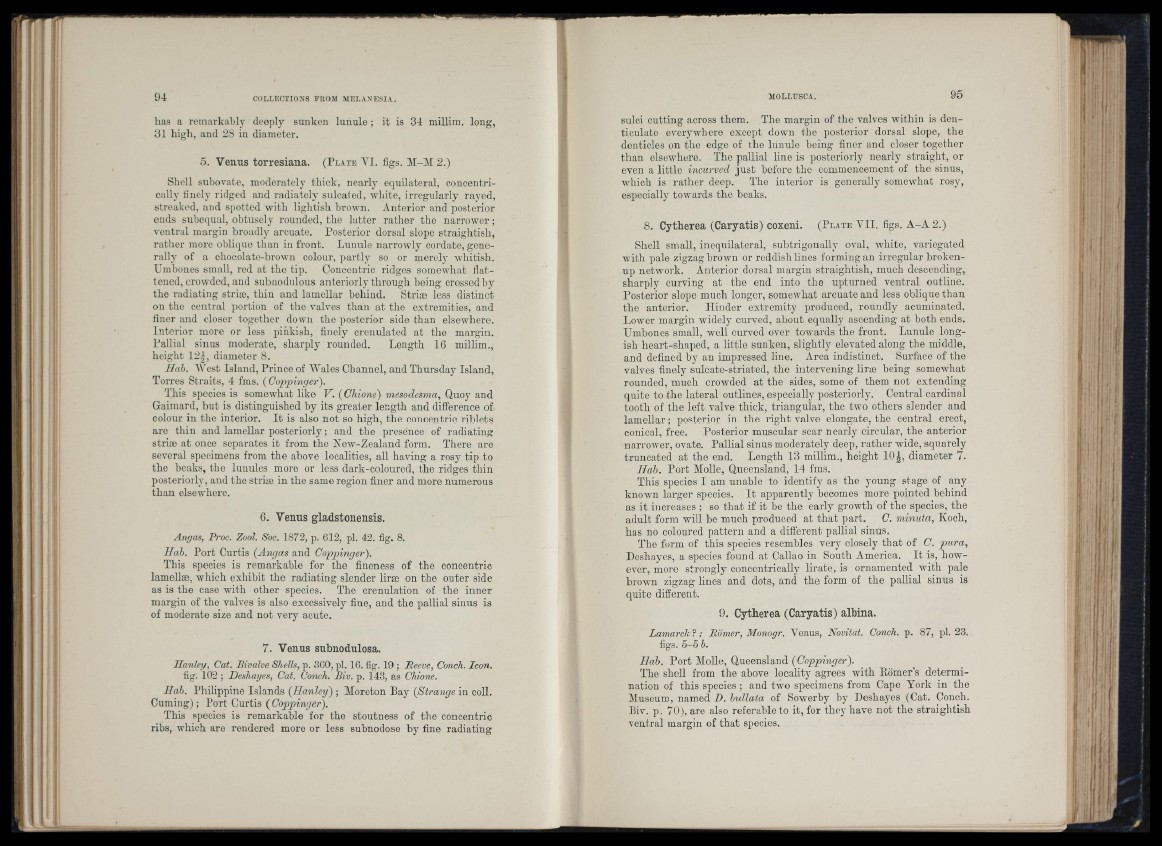
has a remarkably deeply sunken lunule ; it is 34 millim. long,
31 high, and 28 in diameter.
Ïiy
. X
5. Venus torresiana. (P late AH. figs. M-M 2.)
Shell suhovate, moderately thick, nearly equilateral, concentrically
finely ridged and radiately snlcaled, Avhite, irregularly rayed,
streaked, and spotted with liglitish brown. Anterior and posterior
ends subequal, obtusely rounded, the latter rather the narrower ;
ventral margin broadly arcuate. Posterior dorsal slope straightish,
rather more oblique than iu front. Lunule narrowly cordate, generally
of a chocolate-brown colour, partly so or merely whitish.
Umbones small, red at tho tip. Concentric ridges somewhat flattened,
crowded, and snbnodiiloiis anteriorly through being crossed by
the radiating striæ, thin and lamellar behind. Striæ less distinct
on the central portion of the valves than at the extremities, and
finer and closer together down the posterior side than elsewhere.
Interior more or less pinkish, finely crenulated at the margin.
Palliai sinus moderate, sharply rounded. Length 16 millim.,
height 124, diameter 8.
Hab. AVest Island, Prince of AVales Channel, and Thursday Island,
Torres Straits, 4 fms. (Coppinger).
Tliis species is somewhat like V. (Chione) mesodesma, Quoy and
Gaimard, but is distinguished by its greater length and difference of
colour in the interior. I t is also not so high, the concentric rihlets
are thin and lamellar posteriorly ; and the presence of radiating
striæ at once separates it from the New-Zealand form. There are
several specimens from the above localities, all having a rosy tip to
the beaks, the lunules more or less dark-coloured, the ridges thin
posteriorly, and the striæ in the same region finer and more numerous
than elsewhere.
6. Venus gladstonensis.
Anyas, Proc. Zool. Soc. 1872, p. 612, pi. 42. fig. 8.
Hab. Port Curtis (Angas and Coppinger).
This species is remarkable for the fineness of the concentric
lamellae, which exhibit the radiating slender lirae on the outer side
as is the case with other species. The crenulation of the inner
margin of the valves is also excessively fine, and the pallial sinus is
of moderate size and not very acute,
7. Venus suhnodulosa,
Hanley, Cat. Bivalve Shells, p. 360, pi. 16. fig. 19 ; Peeve, Conch. Icon.
fig. 102; Deshayes, Cat. Conch. Biv. p. 143, as Chione.
Hab. Philippine Islands (Hanley) ; Moreton Bay (Strange in coll.
Cuming); Port Curtis (Coppinger).
This species is remarkable for the stoutness of the concentric
ribs, which are rendered more or less suhnodose by fine radiating
sulci cutting across them. The margin of the valves Avithin is denticulate
everywhere except down the posterior dorsal slope, the
denticles on the edge of the lunule being finer and closer together
than elsewhere. The pallial line is posteriorly nearly straight, or
even a little incurved ju s t before the commencement of the sinus,
Avhich is rather deep. The interior is generally somewhat rosy,
especially towards the beaks.
8. Cytherea (Caryatis) coxeni. (P late A*II. figs. A-A 2.)
Shell small, inequilateral, subtrigonally oval, w’hite, variegated
with pale zigzag hroAvn or reddish lines forming an irregular broken-
up network. Anterior dorsal margin straightish, much descending,
sharply curving at the end into the upturned ventral outline.
Posterior slope much longer, someAA'hat arcuate and less oblique tlian
the anterior. Hinder extremity produced, roundly acuminated.
Lower margin widely curved, about equally ascending at both ends.
Umbones small, well curved over towards the front. Lunule longish
heart-shaped, a little sunken, slightly elevated along the middle,
and defined by an impressed line. Area indistinct. Surface of the
valves finely sulcate-striated, the iuterA’ening liriC being somewhat
rounded, much crowded at the sides, some of them not extending
quite to the lateral outlines, especially posteriorly. Central cardinal
tooth of the left valve thick, triangular, the two others slender and
lamellar; posterior in the right valve elongate, the central erect,
conical, free. Posterior muscular scar nearly circular, the anterior
narroAver, ovate. Pallial sinus moderately deep, rather wide, squarely
truncated at the end. Length 13 millim., height 1 0 |, diameter 7.
Hab. Port Molle, Queensland, 14 fms.
This species I am unable to identify as the young stage of any
knoAvn larger species. I t apparently becomes more pointed behind
as it increases ; so th at if it be the early growth of the species, the
adult form will be much produced at th a t part. C. minuta, Koch,
has no coloured pattern and a different pallial sinus.
The form of this species resembles very closely th at of C. pura,
Deshayes, a species found at Callao in South America. I t is, however,
more strongly concentrically lirate, is ornamented with pale
brown zigzag lines and dots, and the form of the pallial sinus is
quite different.
9, Cytherea (Caryatis) alhina.
Lamarck?; Börner, Monogr. Venus, Novität. Conch, p. 87, pi. 23.
figs. 5-5 b.
Bah. Port Molle, Queensland ( Coppinger).
The shell from the above locality agrees with Khmer's determination
of this species; and twm specimens from Cape York in the
Museum, named D. lidlata of Sowerby by Deshayes (Cat. Conch.
Biv. p. 70), are also referable to it, for they have not the straightish
ventral margin of that species.
I l l i
I ,